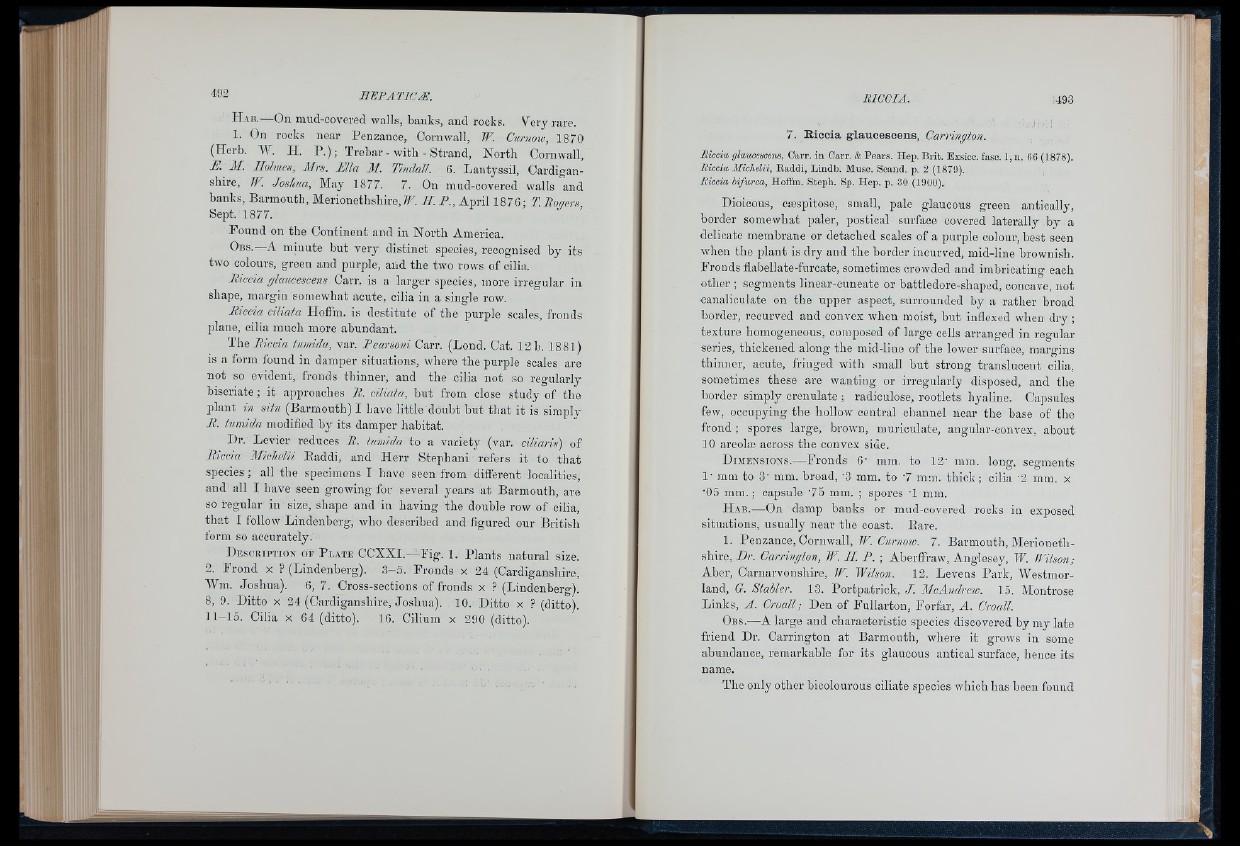
H ab.—On mud-covered walls, banks, and rocks. Yery rare.
1. On rocks near Penzance, Cornwall, W. Curnow, 1870
(Herb. W. H. P .) ; Trebar - with - Strand, North Cornwall,
E. M. Holmes, Mrs. Ella M. Tindall. 6. Lantyssil, Cardiganshire,
W. Joshua, May 1877. 7. On mud-covered walls and
banks, Barmouth, Merionethshire,7P. II. P., April 1876: TEor/ers
Sept. 1877. ’
Pound on the Continent and in North America.
Obs. a minute hu t very distinct species, recognised by its
two colours, green and purple, and the two rows of cilia.
Ihceia glaucescens Carr, is a larger species, more irregular in
shape, margin somewhat acute, cilia in a single row.
Riccia ciliafa Hoffm. is destitute of the purple scales, fronds
plane, cilia much more abundant.
The Riccia tumida, var. Pearsoni Carr. (Lond. Cat. 12 b. 1881)
is a form found in damper situations, where the purple scales are
not so evident, fronds thinner, and the cilia not so regularly
biseriate; it approaches R. ciliafa, but from close study of the
plant in situ (Barmouth) I have little doubt but that it is simply
R. tumida modified by its damper habitat.
Dr. Levier reduces It. tumida to a variety (var. ciliaris) of
Riccia Michehi Eaddi, and Herr Stephani refers it to that
species ; all the specimens I have seen from difierent localities,
and all I have seen growing for several years at Barmouth, are
so regular in size, shape and in having the double row of cilia,
that I follow Lindenherg, who described and figured our British
form so accurately.
Description op P late CCXXI.—Fig. 1. Plants natural size.
2. Frond x ? (Lindenherg). 3-5. Fronds x 24 (Cardiganshire,
Wm. Joshua). 6, 7. Cross-sections of fronds x ? (Lindenherg).
8, 9. Ditto X 24 (Cardiganshire, Joshua). 10. Ditto x ? (ditto).
11-15. Cilia X 64 (ditto). 16. Cilium x 290 (ditto).
7. Riccia glaucescens, Carrington.
Riccia glaiicescens, Carr, in Carr. & Pears. Hep. Brit. Exsicc. fasc. l , n . G6 (1878).
Riccia Miehelii, Raddi, Lindb. Muse. Scand. p. 2 (1879).
Riccia bifurca, Hoffm. Steph. Sp. Hep. p. 30 (1900).
Dioicous, cæspitose, small, pale glaucous green anfcicallj,
border somewhat paler, postical surface covered laterally by a
delicate membrane or detached scales of a purple colour, best seen
when the plant is dry and the border incurved, mid-line brownish.
Fronds flabellate-furcate, sometimes crowded and imbricating each
other ; segments linear-cuneate or battledore-shaped, concave, not
canaliculate on the upper aspect, surrounded by a rather broad
border, recurved and convex when moist, hut inflexed when dry ;
texture homogeneous, composed of large cells arranged in regular
series, thickened along the mid-line of the lower surface, margins
thinner, acute, fringed with small but strong translucent cilia,
sometimes these are wanting or irregularly disposed, and the
border simply crenulate ; radiculose, rootlets hyaline. Capsules
few, occupying the hollow central channel near the base of the
frond ; spores large, brown, muriculate, angular-convex, about
10 areolæ across the convex side.
D im e n s io n s .—Fronds 6’ mm, to 12’ min. long, segments
1' mm to 3' mm. broad, ’3 mm. to '7 mm. thick; cilia '2 mm. x
"05 mm.; capsule '75 mm. ; spores T mm.
H ab.— On damp banks or mud-covered rooks in exposed
situations, usually near the coast. Eare.
1. Penzance, Cornwall, JF. Curnow. 7. Barmouth, Merionethshire,
Dr. Carrington, JF. I I P. ; Aberffraw, Anglesey, W. Wilson;
Aber, Carnarvonshire, JF. Wilson. 12. Levens Park, Westmorland,
G. Stahler. 13. Portpatrick, J. McAndrew. 15. Montrose
Links, A. Croall ; Den of Fullarton, Forfar, A. Croall.
O b s .—A large and charaoteristio species discovered by my late
friend Dr. Carrington at Barmouth, where it grows in some
abundance, remarkable for its glaucous antical surface, hence its
name.
The only other hicolourous ciliate species which has been found